It was a childhood wish of mine to have a secret garden all to myself. I did realise the dream when I was much older and the garden I had then was not quite secret; no garden of a commanding officer’s house can ever be so, no matter how small. Despite this, it contained a secret world which was invisible to all who passed through or passed by but was always available to me whenever I wanted to place the cares of office behind and was ever a source of delight and fascination.
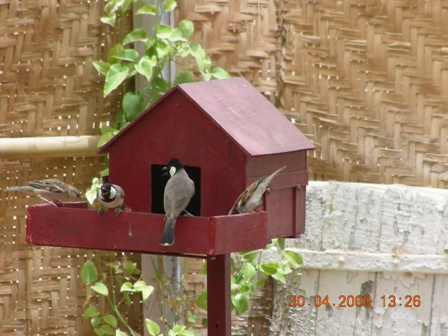
My secret garden
As gardens go, it was a slip of one, hardly 20 yards by 25 yards, just large enough to form the facade of the small two-roomed bungalow in the desert of Jaisalmer where I lived. Indeed it had only a single tree, a patch of grass, some creepers on the fence and a few potted plants but it was peopled by creatures who gave me small glimpses of their lives.
My day begins early, the ploonk plink of bulbuls and the caw caw caw of the crows is infinitely preferable to waking up with the help of an alarm clock. It is just after dawn, the sky is still grey as the sun has not risen over the dunes at the horizon and the breeze which blows cross the sand is still cold. The last vestiges of night-life can occasionally still be seen. Today, a flicker of movement at the corner of my eye causes me to turn my head, just in time to catch a last glimpse of the tail of the large desert monitor (Varanus griseus) who lives behind my bungalow in a hole amidst a tangle of barbed wire. He has a regular nocturnal beat at this time of the year which takes him through the matchbox-sized gardens of the three bungalows side-by-side, then around the large store-house, into the transport yard, across the bordering dune, and back along it on the far side till he rounds the dune, crosses a road and is back into the tiny gardens.
Sometimes, late at night I find a large, prickly and wicked looking arthropod, the solifuge, who patrols my garden each night for insects and small life. Of him, I have written elsewhere.

The hedgehog creeps by night!
About him and the Varanus, the hedgehog does not know or care, for about once a fortnight, he pays me a visit.
It is always dark when he comes for a sip of water from the squirrel-bowl. He easily finds his way in but for some reason stumbles on his way out and so I notice him. He scrambles between the bowl and fence but there is no exit there. He tries the jird’s hole but I lift him and place him on the road outside my bungalow free to go where he wills.
He is easily trapped, and since taking a good picture is difficult, so one day, I catch him and keep him till day-time when I photograph him.

Hedgehog held in hand peeks out!
Hedgehogs are difficult to identify and my guides are not quite comprehensive and the descriptions not specific enough, so, like a lot of amateur naturalists, I call it an Indian Hedgehog and leave it at that.
Night too leaves behind a few small villains, who now appear or can be found where they were not present the previous evening. I am referring, of course, to the scorpions who have the knack of turning up where you never expected to find it – on the outside of the ‘macchar-dani’ (mosquito net), in the folds of the towel on the rack, three feet above the ground or in your boots, the one day you forget to check. Then, its a ”EEYOWW’ followed by the immediate,abrupt and merciless extinction of the perpetrator and later on a local anaesthetic and some salve. A few bites later, you realise it was the fright and unexpectedness which raced your heart more than the pain and it was your ego that required the balm more than the sting.
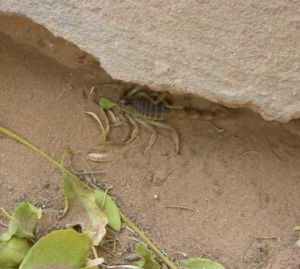
Curses! Discovered again!
Fortunately, I have never found, horror of horrors, the arch-villain, in my shoes or garden – the saw-scaled viper. I’m sure he must be there for my garden is fenced with old duck-boards standing upright, but I never saw him. Nearby yes, but never in my garden.
But lets put these night-time experiences away, for the sun has peeped over the dunes. At this time, strangely, it is not the birds that draw you but the bees. For my garden boasted two hives of bees. They appeared almost together one year after the winter had passed. The largest was in the tree and belonged to Apis florea, the Dwarf Honey Bee. The second hive in the thatch of my garden fence behind a bamboo ‘patti’ screen was the hive of Apis cerana, the Asiatic honeybee. For a brief period these hives flourished, each oblivious of the other, and just as suddenly died out in the autumn. But while they were there, the humming of bees around the sunlit portulacas gave an almost-ethereal feeling to me drowsing in my plastic garden-chair under the tree.

The hive in the tree! (Apis florea)

The hive in the thatch. (Apis cerana)
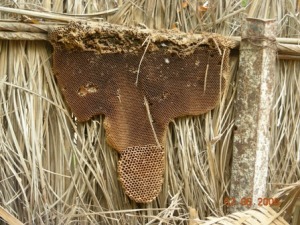
The abandoned thatch hive exposed. Never imagined it to be so large!
The authorities pipe water twice a day, once in the early morning and once ofter dark. So in between these times, you are dependent on water in the roof tanks and stored water in the bathroom buckets. Water is life in the deserts. The pipeline supplying the garden has a small leak at the place where it bends around the garden corner and there it leaks. Each morning, the garden creatures are treated for an hour or so to a thin lamellar flow across a patch of cemented pavement. I have forbidden its repair so that the creatures can get their small but just desserts!
The bees buzz here across the garden from the hive , and like teenagers wearing many pocketed jeans, they pick up water in the small cups or satchels on their legs and take off for the hive. I imagine this water is used to keep the queen and the larvae air-conditioned through the summer. The bees drink greedily of this water and long after it has stopped they crowd the fence, pipe, wet gravel and moist soil with an unquenchable appetite.

Its not just humans who store water each day! (Apis cerana)

The bees crawl everywhere to get at the water. (Apis cerana)
Seeing this and the fact that their presence kept some small creatures away I added two more sources of water. A pot of water hung from a tree branch for the birds and bees and a earthen water-bowl for the squirrels, jirds and other creatures at ground level. Since I was watering them, I decided to feed them, so I added a small wooden feeding tray. The carpenter was so gratified at being asked to do so noble a task that of his own he added a bird-house to the tray. I did’nt have the heart to put him right but gave him an extra shabash! Anyway, the bees now started raiding the water-pot in the mid-morning and afternoons too!

Bees besiege the suspended matka
The white-eared bulbuls (Pycnonotus leucotis) who wake me are not the bulbuls one meets elsewhere in India but are of the white-cheeked variety but without the pointed crests that their cousins from the hills sport. Earlier considered a subspecies, I am told they have been promoted to the rank of a separate species.

The handsome bulbul of the desert!
They fly around, peck at things, warble in the bushes, or on the fence and provide a running commentary on all that’s happening throughout the day. They, along with the squirrels and jirds are my constant companions and I love them dearly. Indeed, one pair did try to nest in the thatch fence but they abandoned the attempt due to a unseasonal heatwave. I pamper them with choicest grains and by shooing away the ‘Bharadwaj’ (Greater Coucal) bird when he calls upon me. They reward me with their melodious calls and assume coquettish postures for my amusement.

The feisty little purple sunbird.
The other residents of my garden include sunbirds, sparrows, doves and crows. The sparrows nest in the eaves, the doves in the storehouse rafters, the crows somewhere in the ad hoc repairs of the roof in my backyard and the sunbirds I know not where.

Mrs Sparrow comes to call on!
It is during the hot hours of the day when I find my most interesting guests. Sometimes it is a Roller perched on a branch under the tree enjoying the coolness just under the canopy where the loo cannot reach directly. On other occasions its a White-browed Fantail, about whom I am constantly admonished by birdwatchers not to refer as a flycatcher any more. Let him catch the two-winged insects, but he must NOT be named as such, declares one soul who fixes me with a glare as if I had just used the much-abhorred ‘n_’ word in a congregation of politically correct citizens.

Remember, a fantail, not a flycatcher! Oh forget it, lets just call it 'Rhipidura aureola'.
During the hot hours of the garden, the creatures are to be found in the shadiest, coolest places. Some, for no conceivable reason why, try other methods. The squirrel who lives in my garden is one such. At this time the birds cling to the shade but off the ground, the jirds are deep underground while Wally the squirrel, so named because he scarfed walnut kernels from her one day, insists on remaining on the sandy floor in the dappled shade below the tree. So to remain in that spot, he resorts to all kinds of tricks. Sometimes, he is on his belly with four hot feet off the ground. Sometimes he grasps the tree trunk while standing on his hind-feet. Intent on his cooling tricks, he fails to notice the bucket of water I send halfway across the garden. Suddenly sodden, he is shocked for an instant before taking off up the tree but I do hope I have helped him remain cool.

Ok, first lets try a belly flop with legs clear of the sand.

Maybe hugging the tree is a better idea.
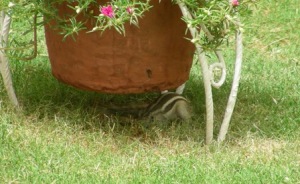
Back to the good old hide in the shadow routine!
One doesn’t quite expect to find butterflies in the desert but they were present alright. The common danaids were present since their foodplant the Aak or Calotropis was present. In my garden. Every day I saw tiny blues which I discovered to be the Dark Grass Blue Zizeeria lysimon. There was also a Pioneer which stayed awhile and moved on. Insect life must exist in greater variety than one expects small pockets in the desert as I also saw a wasp meticulously scour the garden presumably for caterpillars.

The Dark Grass Blue

The visiting Pioneer
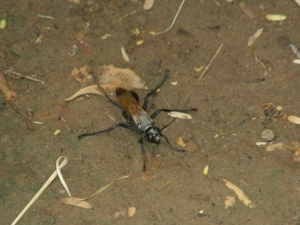
The wasp on the hunt!
The star of the garden is, of course, the jird. Most people call him ‘gerbille’ or ‘kangaroo mouse’; he is neither. His short, rounded ears, chubby body, long thinly haired tail with dark tassel, and shorter legs than one would expect of a mouse looking like a miniature kangaroo, he is the cutest of desert creatures in my garden.

Meet the jird!
One day he turned up in my newly developed garden strolling in as if he owned the place. This was followed by a detailed reconnaissance on his part which culminated with the selection of a spot by the gate where there was adequate shade available. He then proceeded to dig as swiftly, continuously and urgently as he could, realising the risk he faced of being without a bolt-hole. Every few minutes or so, whenever he felt unsafe or uneasy, he would pause and sit upright, facing this way and later that, till he was certain danger had passed. Then he would resume with renewed vigour. Sometimes his head was not seen as it was buried deep but the rear part of his body and his feet were rapidly jerking upwards above the ground level ejecting a constant stream of sand from the hole. Finally, the burrow was done but it was becoming dark.

Slaking its thirst before bossing us around!
Tired but satisfied, he went to have a sip in the newly installed water-bowl but instead sat up at the edge and shrieked angrily. Peering to see what was the problem, I espied Mr and Mrs Todarmal stolidly sitting in the water. Only after I had driven off the indignant toads and changed the water, and also hidden myself in the verandah, would the jird take his sip of water.

The Toadar Mals
Now, master of all he surveys, he shows himself during the day only when it is not too hot. Then he emerges from his burrow, does his personal grooming and then clambers up the side of the bowl to drink his water. Thirst satisfied, he seeks to satisfy his palate. This he does by raiding the bird-seed spilled over the edge of the feeder tray or by nibbling pieces of grass sitting outside his burrow. Should another jird enter the garden, there is a thorough free-for-all until he has vanquished the interloper.
One day I saw another slightly smaller jird and realised he had a mate. But alas, I was not fortunate enough to see their progeny as the military authorities cottoned onto the fact that I was enjoying myself thoroughly and decided to remedy the fact by posting me to the North East.

The honeymooners
Though I am no longer physically present in the desert, in my mind’s eye I can still return to enjoy those pleasurable moments that were once my good fortune to experience.



Recent Comments